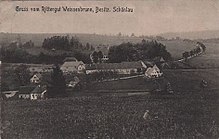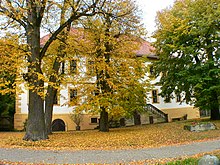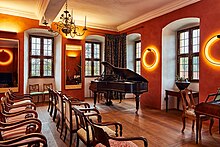Weißenbrunn Palace (Ebern)
The Weissenbrunn Castle lies on the edge of the Eberner local part Weissenbrunn in district Haßberge ( Lower Franconia ). The small baroque country estate is privately owned.
history
Weißenbrunn seems to have been the seat of a lower nobility family as early as the early and high Middle Ages . First mentions, which are not considered certain due to missing sources or possible confusion, go back to the years 804 and 1177, when a "Herald von Wizenbrunn" appeared as a documentary witness in a deed of donation from Bamberg Bishop Otto von Andechs in Weitramsdorf to Langheim Abbey. The first secure documentary evidence dates back to the year 1232. In the parish certificate of the original parish Pfarrweisach, "Wisenbrunnen" (owned by the Lords of Raueneck), like most of the surrounding villages, was assigned to the newly founded parish of Ebern. Later the rule belonged to the Lords von Fuchs , and the Truchseß von Wetzhausen were also feudal lords in the place. Like most of the surrounding castles and palaces, the Weißenbrunn mansion was destroyed along with the hamlet in the Peasants' War in 1525 . According to tradition, this old residence is said to have been on the opposite hill by the old quarry and was part of a chain of hilltop castles that had been newly founded along the Rennweg since the 11th century . They served to protect the prehistoric Höhenweg and later the new valley road that connected the royal courts in the Gäuland. Traces of the terrain or documents relating to the castle stables have not survived.
After the weir systems had increasingly lost their importance as protection along the high path, the Fuchs built a "castle" near the village lake in accordance with the representative requirements of the time. The described location and the architectural emphasis suggest that the former inn in the center of the village (house no. 11) is this old Fuchs' little castle. The economic hardship during and after the Thirty Years War did not stop at the lower nobility either. Georg Adam Fuchs von Bimbach pledged the leasable estate at Weissenbrunn first to the Hanau councilor Johann Daniel Herpfer, the Meiningen councilor Philipp von Schönborn and then to the Würzburg monastery. In 1695, Christoph Hanß Fuchs von Bimbach asked the Bishop of Würzburg to sell the Weißenbrunn fiefdom to Johann Rudolf Moser, the Bambergian Kastner zu Zeil. He sold the manor with the consent of Bishop Johann Gottfried von Guttenberg and the approval of the cathedral chapter on April 7, 1696 to the sergeant-major Georg Philipp von Boyneburg. The rule of the Fuchs family in Weißenbrunn, which had grown over centuries, came to an end.
The Boineburgs were an old noble family that originally came from Hessen. Georg Philipp von Boineburg probably belonged to the Lengsfeld main line of Conradin, a Franconian branch that had its headquarters in the knightly canton of Rhön-Werra, and already owned goods in Dörflis . From 1704 he was the owner of the District Infantry Regiment No. 3, one of the three permanently existing infantry regiments of the Franconian district , and went through a military career in the Franconian district troops, during which he was appointed field marshal-lieutenant. In 1698, Georg Philipp von Boineburg asked the Bishop of Würzburg that the freedom that existed on the little castle at Weißenbrunn should be transferred to another place next to it, where he was thinking of building a castle. This was granted to him and he or his heirs are responsible for the new construction of today's castle. A roof tile of the castle is dated to the year 1723 and according to the style, the building should actually be from this time. Georg Philipp von Boineburg must soon have found himself in financial difficulties. Between 1711 and 1716 he asked the Würzburg bishop for permission from the feudal lord to sell the property in Weißenbrunn to Ludwig A. von Vasolt, but the sale did not take place. After the bishop had initially denied him the admission of funds to the estate in Weißenbrunn, between 1719 and 1737 he approved the pledging against a borrowing of 4000 thalers and finally the sale to Johann Christoph von Varell . However, he had little interest in the manor and sold the castle and manor in 1740 to the Princely Bamberg Privy Councilor Franz Ignaz von Hebendanz, who in turn sold it to his son-in-law Heinrich von Oberkamp in 1749.
The manor now remained for four generations as hereditary fief those of Oberkamp owned, a Catholic, 1629 ennobled in the kingdom knighthood sex. After a request to the Episcopal Ordinariate in Würzburg, a private right to worship to hold holy masses in the castle chapel was obtained in 1752 only for the rulers and their employees. When their father died, their two sons Philipp Joseph and Carl Anton von Oberkamp were still minors. Like her father, she also went through legal training and also belonged to the Bamberg court. In 1791 they were accepted into the Frankish imperial knighthood in the canton of Baunach . When both brothers died in 1806, the manor passed into the possession of Franz von Oberkamp, the son of the elder Philipp Joseph von Oberkamp. This was in the military service of the Duke of Nassau and lived in Wiesbaden, he was probably only rarely present at the manor.
After the dissolution of the imperial knighthood , the only thing left to the nobles as the last remnant of constitutional powers was to set up so-called patrimonial courts. However, the landlords were only responsible for limited police and judicial power over the Grundholden , which was limited to contentious and voluntary jurisdiction. On the manor in Weißenbrunn, Matthias Gottfried Reichenbach was obliged to act as patrimonial judge in constant absence. On the express order of the royal government of the Lower Main District, however, legally qualified personnel had to be called in and paid for in all patrimonial courts for reasons of judicial credibility. For the small manor and with the impoverishment of the subjects, this meant an almost unbearable financial burden. All the more, however, the effort seemed to be made to hold onto one of the last privileges from the Middle Ages and the feudal period for as long as possible and initially pulled Johann Val.Jakob, who was already committed to the patrimonial court of Baron von Rotenhan zu Eyrichshof, also to the court hearings in Weißenbrunn added. In the course of the progressive community formation in Bavaria, the place formed an independent political community together with Welkendorf and Gemünd from 1818 , and a year later Franz von Oberkamp asked for the allodification of his fiefdom. When he finally returned his patrimonial court in Weißenbrunn to the state on January 12, 1820, private jurisdiction in Weißenbrunn came to an end. When he died on February 3, 1832, his son Ludwig was still a minor and therefore Hermann von Rotenhan was initially appointed as a legally obliged guardian for Ludwig von Oberkamp. Johann Jordan had been the tenant of the estate since 1835. The then estate and forest manager Heinrich Volkmar described the economic and social conditions with reference to the still outstanding bonus money and inheritance interest with the words that "the need there was so great that one cannot even describe it." Profitable income seemed to provide only the logging of the forest and the comparatively high construction and improvement costs of 2057 guilders in 1844 suggest that more extensive renovation work was carried out this year.
Almost always absent anyway, Ludwig von Oberkamp finally sold the castle and all of its property on December 27, 1850 for 48,000 guilders to Julius Christian Louis Ludloff (1807–1867), the leaseholder of the Obersiemau and Birkach am Forst manors in the Duchy of Saxony-Coburg . His son Karl (1850–1908), later a Bavarian judicial councilor and father of Carl von Oberkamp , was born at Weißenbrunn Palace. The previous tenant Roth had to leave the property on February 26, 1851, and the district forester Georg Renner had to vacate his official apartment in the castle. Only two years later, in 1852, Louis Ludloff sold the property back to Chamber Councilor Adolf Huschke, as he had obviously taken over financially with the purchase of the former manor. At that time the estate was one of the largest in the Ebern district and comprised 172 daily work fields, 42 daily work meadows and 275 day work forests.
Adolf Huschke, who came from a well-known Lutheran family from Breslau , was an ardent supporter of the Protestants' efforts to clear out the parishes of the Catholic parish association in Jesserndorf . As the Jesserndorf teacher Krimm reported in his chronicle, Adolf Huschke had agreed to provide some rooms for the vicar's apartment and a church service room in his castle until the Protestant church and rectory building in Jesserndorf was completed. Rooms for the Protestant school were also planned in an outbuilding. On March 16, 1855, Johann Lorenz Keßler, the first vicar and teacher of the Protestant branch congregation of Jesserndorf, moved into Weißenbrunn and the first service took place on Palm Sunday, April 1, 1855. The Weißenbrunn Castle was now for three years until the inauguration of the Protestant church in Jesserndorf on October 24, 1858 the place of worship for the Protestant community. After Adolph Huschke died childless in Schweinfurt in 1864, his wife Emilie was initially the sole heir and then the lords of the castle changed more and more frequently. Among the owners were u. a. a Gerold, the manufacturers Engelhardt from Sonneberg and Rätzer from Oberfrohna near Chemnitz, the Schmitt brothers, the economist Karl Gerber from Unterhohenried (a brother of the former clerical councilor Gerber in Ebern ) and the haulier Aßmann, until the estate was finally removed from the Family Schönlau was taken over. In 1952 and 1958, the former manor was hit by two major fires, which destroyed the farm buildings considerably. The former tenant house as well as the manorial sheep barn and the bakery with its two ovens fell victim to the flames.
In 1980 the property was sold by the Schönlau family and completely renovated by the new owner. Since 2016 it has been owned by Wolfgang Kropp and Pia Praetorius , who fundamentally redesigned it and set up a publicly accessible music salon. Chamber concerts have been taking place there since November 2018, followed by catering in other rooms of the castle. The guest house belonging to the castle was also redesigned. Its four apartments are rented out for work and vacation purposes.
Today the old quarry opposite offers a delightful view of the ensemble of a hidden baroque small residence. The secluded location in particular awakens something of the baroque attitude towards life of Franconian knights, who have shaped the cultural landscape of the Haßberge like no other social group. With their castles, they have left a lasting cultural legacy that was a visible expression of their way of life in the 17th and 18th centuries and which, in the countryside, often stood in contrast to everyday reality and the living conditions of the majority of the population.
Building description
The two-storey, rectangular mansion shows typical style elements of the transition period from the Renaissance to the Baroque. The simple, single-wing construction of 11 to 5 window axes rests on a color-contrasting basement and is closed off by a hipped roof. The storeys are separated by a simple belt cornice (round bar cornice) and the corners are enlivened by rusticated corner pilasters , both characteristic features of the late Renaissance. The elevated main entrance on the south side can be reached via a double flight of stairs with a baluster parapet and, like the simple, rectangular portal with segmented gable roofing and drilled windows, is typical of the baroque palace buildings in the region. The interior is also kept simple with an original, spacious wooden staircase. Some rooms have modest decorations made of foliage and ribbon work.
Particularly attractive are the small baroque garden adjacent to the east , which is likely to date from the time it was built and whose strict “French” concept was restored according to old plans, as well as the English park with an old tree population rising to the slope . Such seemingly natural landscape gardens based on the English model did not emerge until later in the second half of the 18th century, when, with the advent of naturalism, the artificial garden creations of the Baroque were increasingly perceived as a violation of nature.
literature
- The art monuments of the Kingdom of Bavaria. Volume 3: Administrative region of Lower Franconia & Aschaffenburg. = The art monuments of Lower Franconia & Aschaffenburg. Issue 15: Hans Karlinger : District Office Ebern. With a historical introduction by Hans Ring. Oldenbourg, Munich 1916 (Unchanged reprint. Ibid 1983, ISBN 3-486-50469-X ).
- Fritz Mahnke: Palaces and castles in the vicinity of the Franconian Crown. 2nd volume. Druck- und Verlagsanstalt Neue Presse, Coburg 1978.
- Anton Rahrbach, Jörg Schöffl, Otto Schramm: Palaces and castles in Lower Franconia - A complete representation of all palaces, manors, castles and ruins in the Lower Franconian independent cities and districts . Hofmann Verlag, Nuremberg 2002, ISBN 3-87191-309-X , p. 166.
- Stephan Kirchner: From the history of the former Weissenbrunn manor. Manuscript, 1998.
Web links
Individual evidence
- ↑ a b Gothaisches genealogisches Taschenbuch der Briefadeligen houses, 1911, p. 686 f.
- ^ Rudolf Friedrich Ludloff: History of the Ludolf-Ludloff family . Roßteutscher, 1910 ( google.de [accessed on November 11, 2017]).
Coordinates: 50 ° 4 ′ 41.5 ″ N , 10 ° 41 ′ 35.5 ″ E







